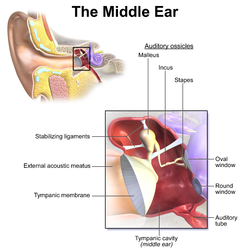| Acoustic reflex | |
|---|---|
 | |
| Identifiers | |
| MeSH | D012022 |
| Anatomical terminology | |
The acoustic reflex (also known as the stapedius reflex,[1] stapedial reflex,[2] auditory reflex,[3] middle-ear-muscle reflex (MEM reflex, MEMR),[4] attenuation reflex,[5] cochleostapedial reflex[6] or intra-aural reflex[6]) is an involuntary muscle contraction that occurs in the middle ear in response to loud sound stimuli or when the person starts to vocalize.
When presented with an intense sound stimulus, the stapedius and tensor tympani muscles of the ossicles contract.[7] The stapedius stiffens the ossicular chain by pulling the stapes (stirrup) of the middle ear away from the oval window of the cochlea and the tensor tympani muscle stiffens the ossicular chain by loading the tympanic membrane when it pulls the malleus (hammer) in toward the middle ear. The reflex decreases the transmission of vibrational energy to the cochlea, where it is converted into electrical impulses to be processed by the brain.
- ^ Davies, R. A. (2016-01-01), Furman, Joseph M.; Lempert, Thomas (eds.), "Chapter 11 - Audiometry and other hearing tests", Handbook of Clinical Neurology, Neuro-Otology, 137, Elsevier: 157–176, doi:10.1016/B978-0-444-63437-5.00011-X, ISBN 9780444634375, PMID 27638069, retrieved 2020-01-05
- ^ "Abnormality of the acoustic reflex (Concept Id: C4022426) - MedGen - NCBI". www.ncbi.nlm.nih.gov. Retrieved 2020-01-05.
- ^ "Definition of auditory reflex | Dictionary.com". www.dictionary.com. Archived from the original on 2023-04-30. Retrieved 2020-01-05.
- ^ Eggermont, Jos J. (2017-01-01), Eggermont, Jos J. (ed.), "Chapter 5 - Types of Hearing Loss", Hearing Loss, Academic Press, pp. 129–173, ISBN 978-0-12-805398-0, retrieved 2020-01-05
- ^ Bear, Mark F.; Connors, Barry W.; Paradiso, Michael A. (2007). Neuroscience. Lippincott Williams & Wilkins. p. 350. ISBN 978-0-7817-6003-4.
- ^ a b Stach, Brad A. (2019-02-22). Comprehensive Dictionary of Audiology: Illustrated, Third Edition. Plural Publishing. p. 225. ISBN 978-1-944883-90-4.
- ^ Fox, Stuart (2006). Human Physiology (ninth ed.). New York: McGraw-Hill. pp. 267–9. ISBN 978-0-07-285293-6.